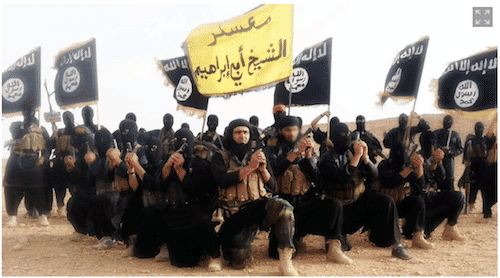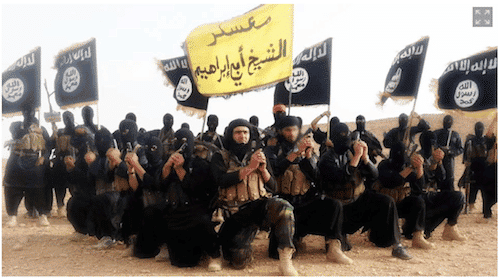Three of the US national government’s self-imposed and surely lethal handicaps in dealing with the Islamist threat are (a) a fixation on looking at the problem in a state-by-state manner; that is, what do we do in Iraq? what do we do in Afghanistan? what do we do in Libya? etc.; (b) an enduring but long-disproved assumption that in its war with Islam the West has time its side; and (c) an addiction to an unwise, unnecessary, and bankrupting interventionism that is the main motivator of the international Islamist movement, a phenomenon which was fathered and is still nurtured by the West’s so-called “allies and friends,” Saudi Arabia, Kuwait, Qatar, etc.
By forming and implementing interventionist policies for each nation-state where an Islamist threat is identified as needing to be addressed, Washington and its NATO allies miss the point that their main Islamist enemies — the Islamic State (IS) and al-Qaeda, and especially the former – think in a regional manner and then design and execute policies meant to establish bases from which they can further expand in a way that advances their ultimate goal of driving the West from the Muslim world and creating an unitary and worldwide Islamic state or caliphate. Whether or not such a state can be created is an open question, but for the time being the subject can be left for academics to endlessly, theoretically, and inconclusively debate, thereby leaving the sane to try to defend the United States.
What is important, at the moment, lies in the quite inexplicable inability of US and NATO policymakers to see what the Islamic State is up to in terms of its regional planning, or how that planning is not only immune to but fueled by the relentless, seriatim intervention of the West in each Muslim country that displeases it – excepting, of course, the Muslim tyrannies the West fawns over, protects, and is bribed by. (NB: This is not to argue that a multi-Muslim-nation intervention by US-NATO forces is needed. First, that mother of all Western interventions would be the single most powerful ally for IS’s goal of uniting the Sunni world. Second, the US military is worn out after two decades of war-losing; is being neutered by Obama’s calculated-to-destroy budget cuts, manpower reductions, and effeminization; and the NATO militaries — save Turkey’s — are tiny, antiquated, underfunded, and could not stop Putin’s panzers from rolling down the Champs Elysees without using nuclear weapons. The only effective US-NATO defense against the Islamists is to stop all intervention, and let the Sunnis, Shias, and Israelis settle their differences in whatever merrily murderous manner pleases them.)
Currently, IS leaders appear to have three strong regional beachheads from which they intend to expand, as well as one strategic economic target: four maritime choke-points that, if closed or even sporadically attacked, would disrupt the world’s supply of oil and hence its economy.
1) The Balkans: IS has established itself strongly in the Islamist communities of Bosnia, Kosovo, and Albania, and has a presence in each of the other Balkan states. In this effort, IS has capitalized on what is now a decades long campaign, that began with the USSR’s demise, in which Saudi Arabia, its Gulf partners, and their NGOs have converted large numbers of Balkans Muslims from being nominal believers to being Muslims well-schooled in the war-prone Salafi and Wahhabi doctrines. The Saudi-led effort has not yet made the Balkans a bastion of those doctrines, but it is yielding increasing numbers of Balkan Muslims who have become Salafis and Wahhabis. These converts have challenged and in several cases succeeded in displacing more moderate Islamic leaders, building Islamist organizations that have sporadically attacked individuals, security forces, and buildings, and have sent a steady stream of volunteers — with the aid of IS logistics units in Turkey, Greece, Spain, and Italy — to fight with IS forces in Syria and Iraq. As the IS presence in the Balkans continues to grow, a glance at the map will show the relative ease with which IS can secure access to EU countries and through the states of Eastern Europe to Russia.
2) Libya: IS is encountering strong local resistance to its presence in Libya but it is an organization that can do more than one thing at a time. While its fighters defend and slowly expand IS-held territory, other IS leaders and administrators are engaged in bringing order and repairing social services and public utilities in the areas they hold, a pattern seen previously in Syria and Iraq. IS also is both exploiting its new geographical position — via successful attacks in Tunisia, and support for the IS organization in Egypt’s Sinai Peninsula — and preparing for further advances from Libya into Algeria, Morocco, Mauritania, and Sudan. Libya also gives IS cross-border access to Niger and Chad, both of which facilitate direct contact with IS’s expanding Nigerian ally Boko Haram. In addition, Niger affords easy entry into Mali where desperate Islamist organizations might well be enticed to cooperate with IS so as to benefit from its military know how, reputation for success, ample treasury, and the return of veteran Malian mujahedin who have been fighting with IS in Syria, Iraq, and Libya.
3) Afghanistan: IS’s presence in Afghanistan is just a year old but its fighters are reported to be deployed in more than half of the countries 34 provinces, in and near the capital of Kabul, and in Pakistan’s tribal region, Baluchistan Province, and the city of Karachi. IS is far from dominating the country, but the trickle of defectors to it from the Afghan and Pakistani Taleban has become a steady flow since the long-hidden death of Taleban chief Mullah Omar was announced on 30 July 2015 and a new leader was quickly chosen by a small number of Taleban leaders who had helped hide the fact that Omar died in April, 2013. IS strategists sees Afghanistan as key to the expansion and completion of the IS Caliphate, as it provides potential revenue streams from the country’s heroin production and mineral wealth, and easy access Pakistan, and through it to India and Kashmir, as well as to the Muslim states of Central Asia, the Muslim Uighur population in China’s Xinjiang Province, and a base from which to potentially attack Iran, murder Shias willy-nilly, and force Tehran to fight a two-front war against IS forces and their allies.
4) Maritime choke-points: In its most ambitious strategic project, IS currently has the beginning of opportunities to establish its presence at four of the world’s most important maritime choke-points. The entrance to Bab-el-Mandab Strait at the southern end of the Red Sea lies between IS and other Islamist groups fighting for control of Yemen and the Islamist- and pirate-rich Horn of Africa; the Suez Canal is vulnerable to the IS branch now operating with near impunity in Egypt’s Sinai Peninsula; the Strait of Malacca, which runs along the shores of Indonesia’s Islamist-dominated Aceh Province; the Jakarta government claims IS’s presence and appeal in the country is quickly growing; and the Strait of Gibraltar, which has long been an al-Qaida target and is now bounded on the south by IS’s growing strength and reach in the Maghreb, and on the north by the ample IS presence in southern Europe and the reinforcements it is receiving from the IS fighters salted among the mass of illegal migrants entering Europe by sea from North Africa.
The foregoing summary describes the unambiguous price of a half-century of US cultural, political, economic, and military interventionism, either unilaterally or with its NATO vassals. And this summary does not include the IS beachheads that are still under development in the North Caucasus and Yemen, which will in time enable IS expansion into Russia and into Saudi Arabia and the other Sunni Gulf States.
In the face of IS’s substantial geographical and manpower expansion, US leaders in both parties have maintained a basically law-and-order approach to the mujahedin and have downplayed — when not ignoring — IS capabilities, its motivation and intentions, and the religious war it is waging. They also have spent the last year wasting time on whining about IS beheadings, the nuclear weapon Iran cannot be prevented from attaining, and stoking war in Europe by aiding a Ukrainian government that cannot defend itself and uselessly sanctioning a Russian regime that will not return Crimea and knows that the term “paper tiger” has never been more applicable than when applied to the United States and NATO.
When the time comes — and it will — for US leaders to look in the cupboard and find a tool with which to end the IS threat, they will find it bare. With two deliberately lost wars, a broken military, a governing elite and president unattached to reality, a bankrupt treasury, a political system corrupted by the US-citizen agents of foreign powers, next-to-useless European allies, a Western world that prefers its own death to slaughtering its enemy, and an Islamist enemy far smarter and more talented than it is given credit for, the US governing elite will have only one option.
Turning from the bare cupboard, these poor souls will know what commonsensical Americans untainted by Ivy League educations have known all along. Namely, that it is time to put America first and to return to General Washington’s foreign-policy legacy by immediately proclaiming the end of US interventionism, the termination of support for all states and groups in the Middle East, the US withdrawal from NATO, and the resumption of America’s most effective national security policy — strict neutrality.
And while doing this, we can all hope — perhaps with misplaced optimism — that it is not too late.
Reprinted with permission from Non-Intervention.com.


